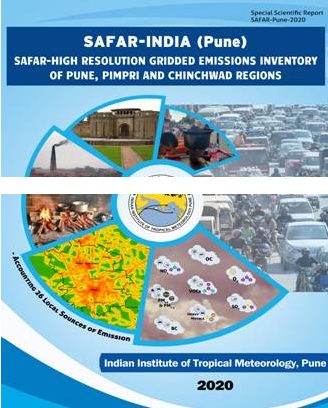Release of- High Resolution Emission Inventory (400 meters) for 2019-20
Mapping the local Sources of pollution in Pune-Pimpri and Chnchiwad region to help policy makers

The most awaited Pune emission inventory report to understand the contribution of various sources of emissions in Pune Air quality has been released by Prof. Nitin Kalmarkar, Vice-Chancellor of SPPU. The final product yielded mapping of pollution sources in each 400m x 400m grid of PMR for 8 major pollutants namely, PM2.5, PM10, NOx, CO, SO2, BC, HC. The report has been released in presence of Director, IITM, Prof. Ravi Nanjundiah, lead author Prof. Gufran Beig, Founder Project Director, SAFAR, and Dr. B.S. Murthy of IITM and Prof. Gosavi, Head, Environment Science Department, SPPU.
 The emission inventory campaign has been led by Indian Institute of Tropical Meteorology (IITM) Pune under the Ministry of Earth Sciences along with SPPU, Pune and under expert advice of Prof. Saroj Kumar Sahu of Utkal University. Geographical Information System (GIS)-based statistical emission model developed by scientist of IITM is used to develop fine resolution of 400m gridded products.
The emission inventory campaign has been led by Indian Institute of Tropical Meteorology (IITM) Pune under the Ministry of Earth Sciences along with SPPU, Pune and under expert advice of Prof. Saroj Kumar Sahu of Utkal University. Geographical Information System (GIS)-based statistical emission model developed by scientist of IITM is used to develop fine resolution of 400m gridded products.
Around 6 months long emission inventory campaign involving more than 200 students from IITM, SPPU and Utkal University was carried out during 2019-20 in Pune Metropolitan region including Pune, Pimpri and Chinchwad regions with around 2,50,000 hours of work. This exercise was tocollect real time primary activity data of 26 differentlocal sources of air pollution.
The click counters, low volume samplers and various survey forms were used to get activity accounting.This exercise was earlier done in 2012-13 at the advent of SAFAR system with a resolution of 1km. Since then significant changes have occurred in land use and demographyand many new sources, which were earlier ignored, have now been quantified.Emission inventory is a scientific way to identify aggregated local source contribution and their region specific spatial distribution within a confined boundary like PMR. It is more effective tool to identify hot spots and plan control measures.
The focus of the present campaign was more towards various small sectors/factors like condition of road, pattern of transport flow from surrounding regions, fast moving-slow moving-stagnant traffic scenario, uninformed sector, construction activity, aviation, practices by immigrant works, hospital rush and vehicles from outside state, changing life styles/cooking habit etc. These will be in addition to traditionally dominating sectors like transport, Industry, residential cooking, Power, suspended dust, trash burning, etc.
The highlights of Emission report is as follows:
A comparison of earlier (Yr-2012-13) emission inventory with the current (Yr-2019-20) inventory in PMR suggests a significant increase in Pune’s overall emission load. The air quality of Pune is mainly regulated by particulate pollutants (PM2.5 and PM10). A significant growth in the emissions of particulate pollutants has been observed during the past seven years. An increase of 70% and 61% is found in PM2.5 and PM10 respectively from 2012-13 to 2019-20. There has been an enormous growth in the number of vehicles in PMR during the past decade. Transportation sector is found to be the major contributor in PM2.5 emissions as compared to rest of the sources. Though industrial production has increased over the years, emissions show a minimal rise as compared to other sectors. This might be due to the improved fuel quality used in units, efficient technological innovations and stringent enforcement of standards. Similarly, a significant increase is observed in the emissions of Organic Carbon (81.3%), NOx (72.8%), and VOCs (69.8%). Sulphur dioxide emissions show a 30.2% increase, lowest amongst the eight pollutants considered in this work.
The emission estimates in such high resolution by SAFAR are likely to serve as an essential information base for scientists, policymakers and NCAP program of CPCB. This report also provides the rate of change in anthropogenic emissions of atmospheric constituents during the past seven years.
Percentage Change in PM10& PM2.5 Emissions during Past 7yrs (2012-13 to 2019-20)
| SECTORS | PM10 | PM2.5 |
| Transport | ↑ 87.9% | ↑ 91.0% |
| Industrial | ↑ 33.8% | ↑ 32.9% |
| Residential* | ↑ 107.7% | ↑ 57.9% |
| WBR Dust | ↑ 49.5% | ↑ 38.1% |
| Other# | NA$ | NA$ |
| Total | ↑ 61.3% | ↑ 70.0% |
* Residential Sector – Residential cooking, Slum, Trash. Burning, Cow Dung, Street Vendor, Household, Wood burning, etc. # Other Sector – MSW Plants, MSW Open Burning, Crematory, Aviation, Incense Stick, Brick Clams, etc. WBR Dust- Wind Blown Re-suspended Dust $ Many sources newly added so not appropriate to show growth.
